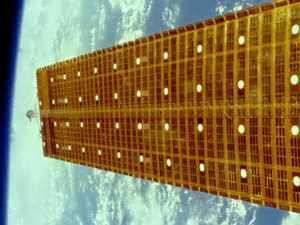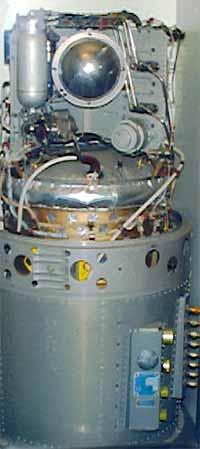|
Power Supply & Control Module

Function:
Electrical Power Supply
Power Storage
Air Supply
Waste Recycling
Mounting for Solar array
Mounting for Communications Antennae
Manoeuvring
Control Solar Heating
Contains fuel cells for power storage
Connected to solar arrays for power generation
Houses main life support systems
Houses main control systems for manoeuvring engines

Solar Arrays
The solar panels on our Station are conveniently located in a fan array on the top of the Power Module.

Solar arrays are large areas of solar cells used to power the Space Station, and other spacecraft and satellites, by energy from sunlight. Anyone who has flown in an aircraft at about 11,000 m (35 000 ft) will know that once above the clouds, the sunlight is very much brighter than on the Earth's surface. In orbit, the space station is about 400 km (250 miles) above the surface, in the Exosphere. Solar cells are therefore a very efficient way of producing free energy for your space station. Solar cells have been used to power space stations, satellites and spacecraft since 1958.
Most solar cells are made of silicon (the main chemical element found in sand), and two other elements - boron and phosphorous. Half of each cell is made of a disc of thin silicon and boron crystal, with the other half made of silicon and phosphorous. The silicon-boron half is called a "P" type silicon and is naturally positively charged; while the silicon-phosporous half is a "N" type and is negatively charged. Together they make a neutral cell.
When photons from sunlight hit the join between the "N" and "P" layers, a flow of electrons - electricity - is produced from one side of the disc to the other, through the crystal structure. By attaching copper wires to each half of the cell, an electrical current is produced. By joining individual cells, in parallel or series, a specific voltage can be generated to power the equipment attached to the solar cells.
Solar energy is one of a number of "alternative" energy sources now used on Earth, others include wind-power and wave power.
The material used for the solar cells is known as a semiconductor. Semiconductors are the basis of electronics. Many common components use semiconductor technology - transistors, diodes, integrated circuits, for instance.
Other semiconductors used for solar cells include gallium arsenide and indium phosphide.
Solar panels are not the only way that electrical power might be generated in space. Others are space tethers and by nuclear power. The latter, however, is no longer an acceptable means aboard orbiting spacecraft, because of the potential hazards should a nuclear reactor re-enter the Earth's atmosphere. It has happened.

Project: Take six coins and six materials, for example:
- Paper - different types, eg plain and printed
- Plastic - different types
- Fabric - different types
- Metal foil
- Rubber
- Washing powder
- Wood
- Scrap piece of a negative from the end of an exposed film
You may think of others.
Put them on a windowsill where they can be exposed to the sunshine. Put a coin on each material. Leave everything for a week or two. Examine the results.
Look for colour differences between the exposed areas and those covered with the coin.
Break or tear the material (if you can). Is there any difference in the way exposed and non exposed areas fail?
Are there any other tests you can devise to check for changes?
The effects are due to ultra-violet radiation in the sunlight. This cannot be seen, but it is harmful if things are over-exposed to it.
Find out about ozone layer depletion. What has this got to do with UV.
Check these sites:
NOAA Weather Service
British Antarctic Survey
Centre for Alternative Technology

Fuel Cells
 Fuel cells are a very efficient way of storing and supplying energy. They are like super re-chargable batteries that store electrical power. They are needed on the space station as a primary source of power when the Station passes into the Earth's shadow and the solar panels no longer function, because they are not in the sunlight. Fuel cells are a very efficient way of storing and supplying energy. They are like super re-chargable batteries that store electrical power. They are needed on the space station as a primary source of power when the Station passes into the Earth's shadow and the solar panels no longer function, because they are not in the sunlight.
The Fuel Cells also supply emergency power in the case of solar panel failure or disconnection and can supply additional short term power during times of high energy usage.
The fuel cell was developed in the United Kingdom in the early 1960's. Its first major application was the the American space programme, however. This fuel cell was used on the Apollo program. It is now on display in the space section of the London Science Museum. © J W Hodges
Project: Find out how the following work:
- Fuel Cell
- Space Tether Generator

Power Regulators and Distribution System
Electrical power is used by the Station for many functions. Without it the Space Station would die. Power cables need to be distributed to all parts of the craft, and different voltages and types of current need to be supplied for different equipment. The electrical distribution must be reliable and have back-up systems in key areas such as life support, attitude control and communication.
Manoeuvring Engines
The Space Station will need to manouevre from time to time. It may have to turn itself around, or point in a particular direction, for instance to align the solar panels with the Sun. This system is called the attitude control. It consists of tiny rocket motors that are located usually on the extremities of the Station, where they can have the greatest turning effect for the smallest use of energy. Such motors are fitted to nearly all space craft, and most of them are ordinary liquid-fuel rocket engines. New motors have been developed, however, called ion engines. these replace hot burning gasses with a stream of ionised particles, which in effect do the same task. By 2020 ion motors will be in common usage and will be fitted to our Space Station.
It also has to boost itself into a higher orbit from time to time, for even up here, at 400 kilometres above Earth there is still some air. This causes a small amount of aerodynamic drag and the Space Station slows down all the time, as a consequence. if this was allowed to continue for long enough it would eventually re-enter the atmosphere, with possibly catastrophic results for those below!
The solution is to fit the Space Station with small rocket engines that can be fired from time to time, to boost the Station into a higher orbit.

Solar Heating
Solar heating is big problem for spacecraft. Designers make great efforts to control heat and cold aboard spacecraft. The side exposed to the Sun will heat up, while the parts in shadow will be exposed to the cold of space and will cool. Distributing the heat is a priority, because things expand and contract with temperature and the resulting stress can cause damage, vibration, electricty fluctuations and many other unwanted effects.
Generally you need to:
- a) keep everything at around the same temperature
- b) make sure it is not too hot
- c) make sure it is not too cold
On current space stations, radiators fixed to external booms are used to get rid of unwanted heat. This comes not just from solar effects but from that generated by equipment on-board. By 2020 it should be possible to convert this low-grade excess heat into other forms of energy - electricity, perhaps - for use on the Space Station. And radiators won't be needed.
There are several other ways that spacecraft control heating, for example:
- Colour
- Metalised wrap - gold mylar film
- Mirror surfaces
- Ablative tiles
Colour is important. Black or dark objects tend to absorb heat radiation, while white or light objects reflect heat. Imagine being a zebra! Reflective surfaces reflect heat as well as light, and two methods are commonly used on spacecraft, if practical. Gold mylar film is cheap and effective but easily damaged, while mirror surfaces are equally good and more robust, but expensive and only usable in large flat areas.
The Space Shuttle Orbiter is covered in thick ceramic (very special pottery) tiles that are very heat absorbent. It is referred to as ablative material, and stops the metal skin and inside of the shuttle from getting hot as it reenters the Earths atmosphere at very high speed after a mission in space. In fact if you pick up a red-hot lump of this tile material it will not burn you! It cannot transfer heat very easily. It is a very good heat insulator, so stops heat being transfered to the metal Shuttle.
The tiles were extremely expensive to develop and caused NASA many problems in the early days of the Shuttle's history.
At the time of writing, only three space agencies are known to have successfully built and operated re-entry vehicles that can return to Earth from space, Russia, USA and China.
The Chinese Space Agency has developed the most elegant and amazingly cheap method of building a re-entry shield for their single-use re-entry vehicles. They use oak wood. A thick piece oak is an ideal insulator and ablative material. Oak burns very slowly and it doesnot transfer heat very readily. Oak buildings are very difficult to burn down, which is why so many old oak buildings are still in existance around the world. Anyone who has ever tried to burn oak logs on a fire will confirm this. A big, hot fire is needed to ignite oak, and it will burn slowly for hours.
So, the message here is that modern, hi-tech solutions are not necessarily the answer to the problems of living in space. Simple, cheap and well-tried solutions may serve just as well in some cases, even with respect to highly technical problems.
However, can you think of some reasons why oak tiles would be unsuitable for the Space Shuttle?

Project:
Get some coins, put them on a plastic or wooden tray (a good heat insulator) and cover each one with a small blanket. make sure the blanket is in contact with the coin. The blanket should made of different combinations of colours and materials, for example:
Black paper, white paper
Blue cloth, blue paper
Gold foil, silver foil
Ensure the materials are a variety of colours and reflectivity (some shiny some dull).
Leave them in the sunshine to warm up for an hour or so, then remove the blankets, one by one and test the temperature of the coins. It is best to use a digital thermometer, but a finger will do.
What are your discoveries?
Does colour and material have an effect on how hot the coin gets?
What if you put two blankets on - say shiny foil over black paper?

Answer to the micrometeoroid problem: Enough energy to run the electric fire for more than 8 days!

Go to Space Station 2020 Specification
Return to title page
 |













